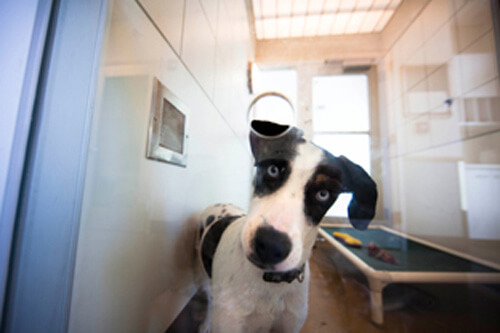Group Housing: Part One
Co-housing dogs with other dogs must be a consideration for shelters that house dogs long-term, meaning longer than two weeks. Providing dogs (who enjoy the company of other dogs) with a ‘roommate’ provides them with social enrichment which may alleviate boredom and stress, and increase happiness. Happiness is difficult to measure, but must not be underestimated. Group housing is usually NOT enriching when it isn’t carefully considered and planned.
The Association of Shelter Veterinarians’ Guidelines for Standards of Care in Animal Shelters states:
“There are both risks and benefits to group housing. Inappropriately used group housing creates physical risks of infectious disease exposure and injury or death from fighting. It also creates stress, fear, and anxiety in some members of the group. Group housing makes monitoring of individual animals more difficult, resulting in failure to detect problems or inadequate access to necessities like food and water for some animals. Staff safety may also be compromised when animals are housed in groups as it is generally more difficult to manage more than one animal in an enclosure. However, appropriately planned groups for housing or play can be acceptable, and may even be desirable, when tailored to individual animals (Griffin 2002, 2006; Gourkow 2001: Kessler 1999b; Mertens 1996; Overall 1997; Rochlitz 1998). Benefits of group housing include opportunities for positive interaction with other animals including play, companionship, physical connection, and socialization. Group housing can be used to provide a more enriched and varied environment.”
‘Appropriately planned groups’ means that each dog must have/receive:
- Adequate space so that they can spend time together when desired, and avoid each other when desired.
- Ability to eliminate away from their food, water, and resting place.
- A food bowl
- Adequate water supply
- A bed
- A compatible roommate(s) – the dogs appear to enjoy spending time together
- Solitary housing if they don’t enjoy spending time with other dogs
- Daily monitoring of well-being, including evaluation of behavioral health, appetite, and medical health.
- Close monitoring of behavior, to reduce the likelihood of serious fights/aggression.
Is your shelter ready to do all this? If the answer is yes, the first step is to assess your shelter’s capacity and resources.

Resources
Physical space: There are no standards or guidelines for the dimensions of how much space group housed dogs should have. At a minimum, each dog should have enough space to: stand on hind legs and extend front legs on a wall or door; lie on their side; eliminate away from their food and resting areas; and move/stay away from other dogs when desired.
People: One person must be responsible for creating and supervising the group housing protocol. Others must be responsible for implementing it. Dogs must be assessed for compatibility and introduced in a way that maximizes the likelihood that they will enjoy their time together. Regular monitoring and re-assessment is important as matches that seemed compatible at the start may not be over time. This topic is covered in ‘group housing, part two’.
Capacity: Capacity refers to the shelter’s ability to ADEQUATELY care for the number of animals in the shelter.
– Group housing does NOT have the benefit of allowing you to house twice the number of dogs that you previously cared for. Unless you can also double the number of staff and/or volunteers, equipment needed for the dogs, etc., your shelter probably doesn’t have the capacity to appropriately care for more dogs and provide them with good welfare.
– Increasing the number of animals in the shelter without a plan for how to care for them often results in poor welfare.
What this means in terms of actual measurements… we don’t know yet. There is a lot we do not know with regard to group housing. More research is needed to help us determine how much space is needed. Research is needed on topics such as:
- How much space is enough space?
- Are potential adopters more vs. less likely to select a dog who is housed with another dog?
- Does group housing reduce stress and improve welfare?
- Which dogs do well with group housing and which do not?
- How frequently do serious fights (resulting in injury) occur when dogs are group housed?
- Does the incidence of fights increase vs. decrease depending on dogs’ demographic characteristics (small vs. large, male vs. female, neuter status)?
In part two of this post, we will discuss some research findings and recommendations for group housing.
Stay tuned!
– Dr. Sheila D’Arpino, Veterinary Behaviorist, Center for Shelter Dogs and Seana Dowling, Interim Executive Director, Center for Shelter Dogs
